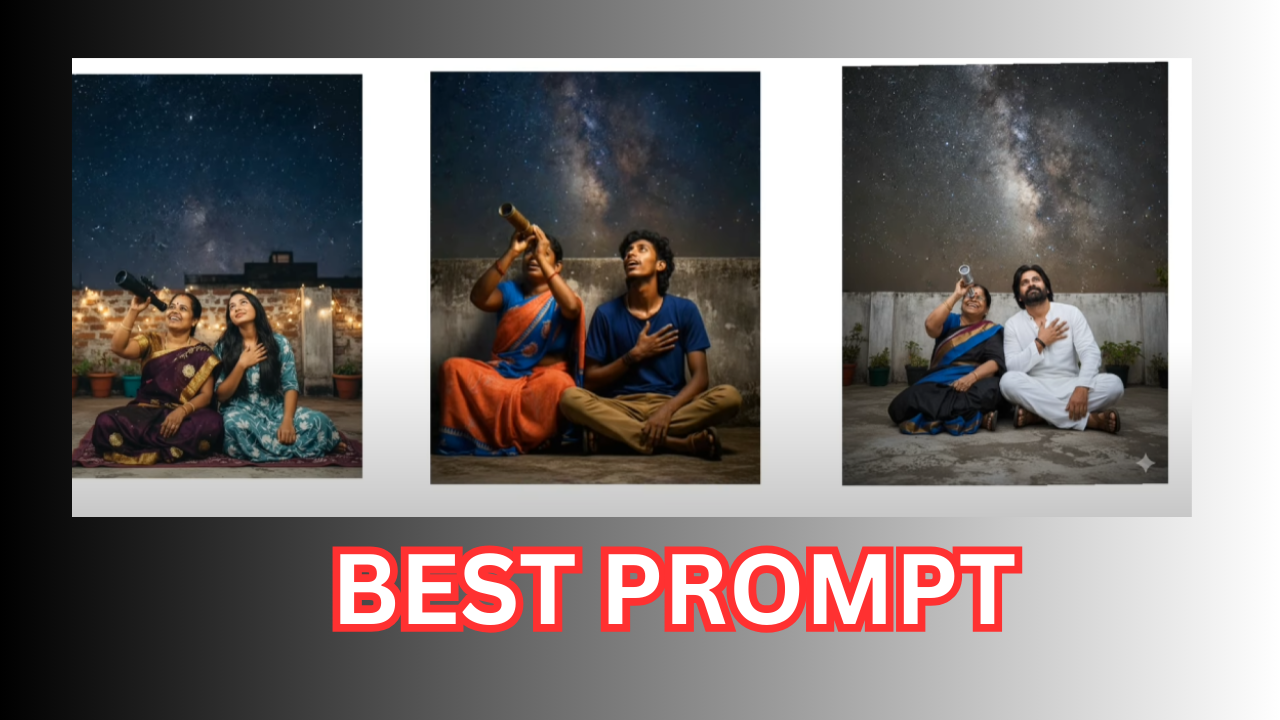HERE IS THE PROMPT
Deeply emotional, heartwarming, and poignant shot of a young man and his mother sharing a moment of wonder and connection on a home terrace at night.
300
Setting and Atmosphere:
Location: A simple, quiet home terrace at night.
Background: The pair is sitting on the ground, leaning against a simple, rough concrete wall.
Lighting: Soft, dramatic, high-contrast lighting (like an HD camera effect) that is slightly moody. A single light source should illuminate their faces and the foreground softly, emphasizing the moment. The background is dark, showing a hint of the night sky (though the focus is on the people).
The Mother:
She is sitting on the ground, wearing a traditional saree in colors similar to the photo provided (a deep maroon/red with a bright teal/turquoise border or pallu).
Her expression is one of focused wonder.
She is holding a small, handheld object like a telescope or a spyglass, looking up towards the night sky.
The Son (You):
He is sitting directly next to his mother.
INTRODUCTION
The word prompt may seem simple, but it carries a wide range of meanings, applications, and significance across different domains of life, language, and technology. At its core, a prompt can be defined as something that encourages, stimulates, or initiates an action or response. The origin of the term lies in the Latin word promptus, which means “brought forth” or “readily visible.” Over time, it evolved in English to represent swiftness, readiness, or an urging signal. In everyday conversation, when someone is described as prompt, it usually refers to being quick to act or respond without unnecessary delay. However, in modern times, especially with the rise of computers and artificial intelligence, the word has taken on an even broader and more technical meaning.
ABOUT THIS PROMPT
In debates or discussions, prompts help participants focus on a particular subject and avoid wandering off-topic. Similarly, in counseling or therapy, prompts are used by psychologists to guide their clients into deeper reflection, such as asking “How did that experience make you feel?” These forms of prompting highlight how a small, well-phrased question or suggestion can lead to significant exploration of ideas, emotions, and knowledge. Without prompts, many conversations would remain shallow or directionless.
This simple symbol represents a gateway between the human mind and the machine, a space where instructions are given and responses are returned. Even though modern computers now rely heavily on graphical user interfaces, prompts remain deeply embedded in programming, system administration, and technical tasks. They remind us that machines require precise instructions, and prompts are the key to unlocking their functionality.
Key Principles
To get the best results, you’ll want to follow prompt engineering best practices. Some documented tips from Google and user experiences include:
- Be clear & specific
Tell Gemini exactly what you want: task, constraints, style, length, format. The more precise your instructions, the better the model can follow. - Provide context or role framing
If your prompt involves domain knowledge , tell Gemini your level (beginner, advanced) and the perspective (teacher, consultant).
subject
A prompt for image generation is a text-based instruction that tells an AI exactly what kind of image to create. It is essentially the blueprint for the AI’s imagination. The more detailed and specific your prompt, the more accurate and visually appealing the resulting image will be. A well crafted prompt usually includes several key components. First, the subject this is what you want the image to be about, such as a person, animal, object, or scene.
Next are the details or attributes, which describe specific characteristics, poses, actions, or features, like “a majestic white tiger with piercing blue eyes walking through a dense jungle. Then comes the style or mood, which directs the AI to create the image in a particular artistic or photographic style, such as digital painting, realistic photo, watercolor art, or “cinematic lighting.
HOW TO DO
Adding camera perspective or angle can enhance realism or storytelling, for example, “aerial view of a bustling city at night” or “close-up portrait with shallow depth of field.” The prompt can also include color schemes and lighting, like “warm golden hour tones” or “neon lights reflecting on wet streets,” which help set the atmosphere.
Additionally, some AI platforms allow negative prompts, which specify what should be excluded from the image, such as “no text, no blur, no extra people.” Crafting an effective prompt is both an art and a science: it requires balancing specificity with creativity, using descriptive adjectives, and combining visual, stylistic, and technical details.
For instance, a complete prompt might read, “A futuristic cyberpunk city at night, neon lights reflecting on wet streets, flying cars in the sky, cinematic lighting, high-resolution, wide-angle perspective, in a detailed digital art style, no text, no blur.”
This level of detail ensures the AI fully understands the creator’s vision and produces an image that closely matches expectations.
Overall, prompts are the essential link between human imagination and AI-generated visuals, and learning to write them effectively allows anyone to transform ideas into stunning digital art with precision, creativity, and style.
